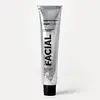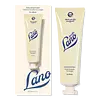What's inside
What's inside
 Key Ingredients
Key Ingredients

 Benefits
Benefits

 Concerns
Concerns

 Ingredients Side-by-side
Ingredients Side-by-side

Water
Skin ConditioningSorbitan Olivate
EmulsifyingCetearyl Olivate
Glyceryl Stearate
EmollientSimmondsia Chinensis Seed Oil
EmollientGlycerin
HumectantCocos Nucifera Oil
MaskingTheobroma Cacao Seed Butter
EmollientAstrocaryum Murumuru Seed Butter
EmollientMauritia Flexuosa Fruit Oil
Skin ConditioningHelianthus Annuus Seed Cera
EmollientCetearyl Alcohol
EmollientGlyceryl Caprylate
EmollientBertholletia Excelsa Seed Oil
EmollientPentaclethra Macroloba Seed Oil
EmollientTheobroma Grandiflorum Seed Butter
Skin ConditioningTocopherol
AntioxidantLavandula Angustifolia Oil
MaskingXanthan Gum
EmulsifyingCetearyl Glucoside
EmulsifyingLinalool
PerfumingCananga Odorata Flower Oil
MaskingSodium PCA
HumectantErythritol
HumectantSorbic Acid
PreservativeBenzoic Acid
MaskingCarrageenan
Limonene
PerfumingBenzyl Benzoate
AntimicrobialAscorbyl Palmitate
AntioxidantGeraniol
PerfumingFarnesol
PerfumingBenzyl Salicylate
PerfumingGlucose
HumectantWater, Sorbitan Olivate, Cetearyl Olivate, Glyceryl Stearate, Simmondsia Chinensis Seed Oil, Glycerin, Cocos Nucifera Oil, Theobroma Cacao Seed Butter, Astrocaryum Murumuru Seed Butter, Mauritia Flexuosa Fruit Oil, Helianthus Annuus Seed Cera, Cetearyl Alcohol, Glyceryl Caprylate, Bertholletia Excelsa Seed Oil, Pentaclethra Macroloba Seed Oil, Theobroma Grandiflorum Seed Butter, Tocopherol, Lavandula Angustifolia Oil, Xanthan Gum, Cetearyl Glucoside, Linalool, Cananga Odorata Flower Oil, Sodium PCA, Erythritol, Sorbic Acid, Benzoic Acid, Carrageenan, Limonene, Benzyl Benzoate, Ascorbyl Palmitate, Geraniol, Farnesol, Benzyl Salicylate, Glucose
Water
Skin ConditioningLanolin
EmollientCetearyl Alcohol
EmollientCaprylic/Capric Triglyceride
MaskingGlyceryl Stearate
EmollientButyrospermum Parkii Butter
Skin ConditioningPrunus Amygdalus Dulcis Oil
Skin ConditioningVitis Vinifera Seed Oil
EmollientGlycerin
HumectantPhenoxyethanol
PreservativeSodium Stearoyl Glutamate
CleansingCetearyl Glucoside
EmulsifyingCetearyl Olivate
Sorbitan Olivate
EmulsifyingCarrageenan
Benzyl Alcohol
PerfumingParfum
MaskingTocopherol
AntioxidantNonfat Dry Milk
Skin ConditioningAscorbic Acid
AntioxidantGlycine Soja Oil
EmollientCitric Acid
BufferingDaucus Carota Sativa Root Extract
Skin ConditioningBeta-Carotene
Skin ConditioningLimonene
PerfumingLinalool
PerfumingWater, Lanolin, Cetearyl Alcohol, Caprylic/Capric Triglyceride, Glyceryl Stearate, Butyrospermum Parkii Butter, Prunus Amygdalus Dulcis Oil, Vitis Vinifera Seed Oil, Glycerin, Phenoxyethanol, Sodium Stearoyl Glutamate, Cetearyl Glucoside, Cetearyl Olivate, Sorbitan Olivate, Carrageenan, Benzyl Alcohol, Parfum, Tocopherol, Nonfat Dry Milk, Ascorbic Acid, Glycine Soja Oil, Citric Acid, Daucus Carota Sativa Root Extract, Beta-Carotene, Limonene, Linalool
 Reviews
Reviews

Ingredients Explained
These ingredients are found in both products.
Ingredients higher up in an ingredient list are typically present in a larger amount.
Carrageenan comes from red seaweed or algae. It is made up of polysaccharides and a highly flexible compound. Red algae cell walls are rich in carrageenan.
In cosmetics, it helps to thicken the texture. Studies show carrageenan extracted from red algae possess antioxidant properties. Components found in carrageenan include: lipids, fatty acids, Vitamin E, proteins, and several amino acids.
Learn more about different types of algae.
Carrageenan is also commonly used in medicine and food. It is a vegan alternative to animal-based gelatin.
Learn more about CarrageenanCetearyl alcohol is a mixture of two fatty alcohols: cetyl alcohol and stearyl alcohol. It is mainly used as an emulsifier. Emulsifiers help prevent the separation of oils and products. Due to its composition, it can also be used to thicken a product or help create foam.
Cetearyl alcohol is an emollient. Emollients help soothe and hydrate the skin by trapping moisture.
Studies show Cetearyl alcohol is non-toxic and non-irritating. The FDA allows products labeled "alcohol-free" to have fatty alcohols.
This ingredient is usually derived from plant oils such as palm, vegetable, or coconut oils. There is debate on whether this ingredient will cause acne.
Due to the fatty acid base, this ingredient may not be Malassezia folliculitis safe.
Learn more about Cetearyl AlcoholCetearyl Glucoside is a surfactant and emulsifier. It can be produced from synthetic of natural sources of cetearyl alcohol and glucose.
Emulsifiers help prevent ingredients from separating, such as oils and waters. It can also be used to enhance the texture of products.
As a surfactant, Cetearyl Glucoside helps during the cleansing process. By gathering all the dirt and oils, it allows these molecules to be washed away easily.
Learn more about Cetearyl GlucosideCetearyl Olivate is an emulsifier and texture enhancer. It is derived from the fatty acids of olive oil and Cetearyl alcohol, and is biodegradable.
As an emulsifier, it is used to prevent oils and waters from separating. It can also
Manufacturers use the name Olivem 1000. This ingredient has been found to preserve the natural microbiome of skin. Having a healthy microbiome helps keep our skin healthy and protects against harmful bacteria. This ingredient is grouped with Sorbitan Olivate under the name Olivem 1000.
Learn more about Cetearyl OlivateGlycerin is already naturally found in your skin. It helps moisturize and protect your skin.
A study from 2016 found glycerin to be more effective as a humectant than AHAs and hyaluronic acid.
As a humectant, it helps the skin stay hydrated by pulling moisture to your skin. The low molecular weight of glycerin allows it to pull moisture into the deeper layers of your skin.
Hydrated skin improves your skin barrier; Your skin barrier helps protect against irritants and bacteria.
Glycerin has also been found to have antimicrobial and antiviral properties. Due to these properties, glycerin is often used in wound and burn treatments.
In cosmetics, glycerin is usually derived from plants such as soybean or palm. However, it can also be sourced from animals, such as tallow or animal fat.
This ingredient is organic, colorless, odorless, and non-toxic.
Glycerin is the name for this ingredient in American English. British English uses Glycerol/Glycerine.
Learn more about GlycerinGlyceryl Stearate is a mix of glycerin and stearic acid.
It is used to stabilize the mixing of water and oil ingredients. By preventing these ingredients from separating, it can help elongate shelf life. It can also help thicken the product's texture.
As an emollient, it helps soften skin and supports barrier-replenishing ingredients.
In cosmetics, Glyceryl Stearate is often made from vegetable oils or synthetically produced.
This ingredient may not be fungal-acne safe
Fun fact: The human body also creates Glyceryl Stearate naturally.
Learn more about Glyceryl StearateLimonene is a fragrance that adds scent and taste to a formulation.
It's found in the peel oil of citrus fruits and other plants such as lavender and eucalyptus. The scent of limonene is generally described as "sweet citrus".
Limonene acts as an antioxidant, meaning it helps neutralize free radicals.
When exposed to air, oxidized limonene may sensitize the skin. Because of this, limonene is often avoided by people with sensitive skin.
The term 'fragrance' is not regulated in many countries. In many cases, it is up to the brand to define this term. For instance, many brands choose to label themselves as "fragrance-free" because they are not using synthetic fragrances. However, their products may still contain ingredients such as essential oils that are considered a fragrance.
Learn more about LimoneneLinalool is a fragrance and helps add scent to products. It's derived from common plants such as cinnamon, mint, citrus, and lavender.
Like Limonene, this ingredient oxidizes when exposed to air. Oxidized linalool can cause allergies and skin sensitivity.
This ingredient has a scent that is floral, spicy tropical, and citrus-like.
Learn more about LinaloolSorbitan Olivate is created from the fatty acids in olive oil and sorbitol.
This ingredient is an oil in water emulsifier. It helps stabilize a product by preventing oils and waters from separating. Sorbitan Olivate also helps hydrate the skin.
Manufacturers sell sorbitan olivate under the name OliveM 1000. OliveM 1000 a multifunctional ingredient. It is self-emulsifying. According to a manufacturer, OliveM 1000 does not disrupt natural skin biome.
Due to its olive oil base, this ingredient may not be fungal-acne safe.
Learn more about Sorbitan OlivateTocopherol (also known as Vitamin E) is a common antioxidant used to help protect the skin from free-radicals and strengthen the skin barrier. It's also fat soluble - this means our skin is great at absorbing it.
Vitamin E also helps keep your natural skin lipids healthy. Your lipid skin barrier naturally consists of lipids, ceramides, and fatty acids. Vitamin E offers extra protection for your skin’s lipid barrier, keeping your skin healthy and nourished.
Another benefit is a bit of UV protection. Vitamin E helps reduce the damage caused by UVB rays. (It should not replace your sunscreen). Combining it with Vitamin C can decrease sunburned cells and hyperpigmentation after UV exposure.
You might have noticed Vitamin E + C often paired together. This is because it is great at stabilizing Vitamin C. Using the two together helps increase the effectiveness of both ingredients.
There are often claims that Vitamin E can reduce/prevent scarring, but these claims haven't been confirmed by scientific research.
Learn more about TocopherolWater. It's the most common cosmetic ingredient of all. You'll usually see it at the top of ingredient lists, meaning that it makes up the largest part of the product.
So why is it so popular? Water most often acts as a solvent - this means that it helps dissolve other ingredients into the formulation.
You'll also recognize water as that liquid we all need to stay alive. If you see this, drink a glass of water. Stay hydrated!
Learn more about Water